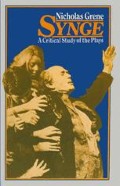Abstract
Synge’s cautiously worded letter to the Irish Times, following the ‘Playboy riots’, is well known. To critics of the play, it reads like a challenge to understand the complexities of a work which the Dublin audiences had so completely failed to comprehend. Synge’s ‘hint’ has not been neglected; several sides of The Playboy have been thoroughly investigated, and it has been looked at in a number of different lights. The letter, however, still illustrates the peculiar critical problems which the play raises. It is accepted that there are ‘several sides’ to The Playboy, but it is hard to avoid stressing one side at the expense of another, difficult to find a critical view which will adequately represent the play’s multiplicity. The Playboy is accepted as ‘serious’. There it is in all the anthologies of modern drama — no one is likely to dismiss it as a slight extravaganza. The problem indeed is how to handle its seriousness lightly enough, how to interpret a serious play which includes scenes of extravagant comedy.
The Playboy is not a play with a ‘purpose’ in the modern sense of the word, but, although parts of it are or are meant to be extravagant comedy, still a great deal that is in it and a great deal more that is behind it is perfectly serious when looked at in a certain light. This is often the case, I think, with comedy, and no one is quite sure today whether Shylock or Alceste should be played seriously or not. There are, it may be hinted, several sides to The Playboy.1
Access this chapter
Tax calculation will be finalised at checkout
Purchases are for personal use only
Preview
Unable to display preview. Download preview PDF.
Notes
M. J. Sidnell, ‘Synge’s Playboy and the Champion of Ulster’, Dalhousie Review, Vo1. 45 (1965) 51–9.
Mary Rose Sullivan, ‘Synge, Sophocles, and the Un-Making of Myth’, Modern Drama, Vol. XII (1969) 242–53.
Hugh H. MacLean, ‘The Hero as ‘Playboy’, University of Kansas City Review, Vol. xxi (1954) 9–19.
Stanley Sultan, ‘A Joycean Look at The Playboy of the Western World’, in The Celtic Master, ed. M. Harmon (Dublin, 1969) pp. 45–55.
Alan Price, Synge and Anglo-Irish Drama (London, 1961) p. 162.
Una Ellis-Fermor, The Irish Dramatic Movement (London, 1939) p. 177.
Patricia Meyer Spacks, ‘The Making of the Playboy’, Modern Drama, IV (1961) 314–23; reprinted in Twentieth Century Interpretations of The Playboy of the Western World, ed. T. R. Whitaker (Englewood Cliffs. N.J., 1960) pp. 75–87.
Howard D. Pearce, Synge’s Playboy as Mock-Christ’, Whitaker (ed.), Twentieth Century Interpretations, pp. 88–97.
Ronald Peacock, The Poet in the Theatre (London, 1946) p. 95.
R. R. Sanderlin, ‘Synge’s Playboy and the Ironic Hero’, Southern Quarterly, Vol. 6 (1968) 289–301.
J. F. Kilroy, ‘The Playboy as Poet’, PMLA, Vol. 83 (1968) 439–442.
Arthur Ganz, ‘J. M. Synge and the Drama of Art’, Modern Drama, Vol. X (1967) 57–68.
Padraic Colum, The Road Round Ireland (New York, 1926) p. 368.
Ibid., pp. 268–9.
Copyright information
© 1985 Nicholas Grene
About this chapter
Cite this chapter
Grene, N. (1985). Approaches to The Playboy . In: Synge. Palgrave Macmillan, London. https://doi.org/10.1007/978-1-349-07672-7_7
Download citation
DOI: https://doi.org/10.1007/978-1-349-07672-7_7
Publisher Name: Palgrave Macmillan, London
Print ISBN: 978-0-333-38388-9
Online ISBN: 978-1-349-07672-7
eBook Packages: Palgrave Literature & Performing Arts CollectionLiterature, Cultural and Media Studies (R0)

